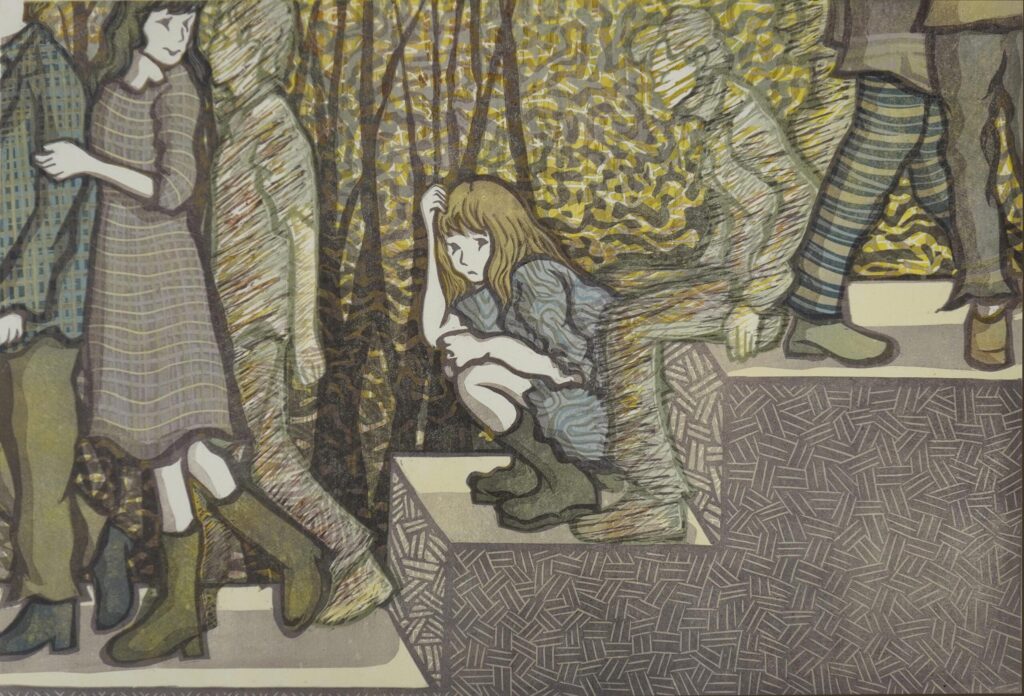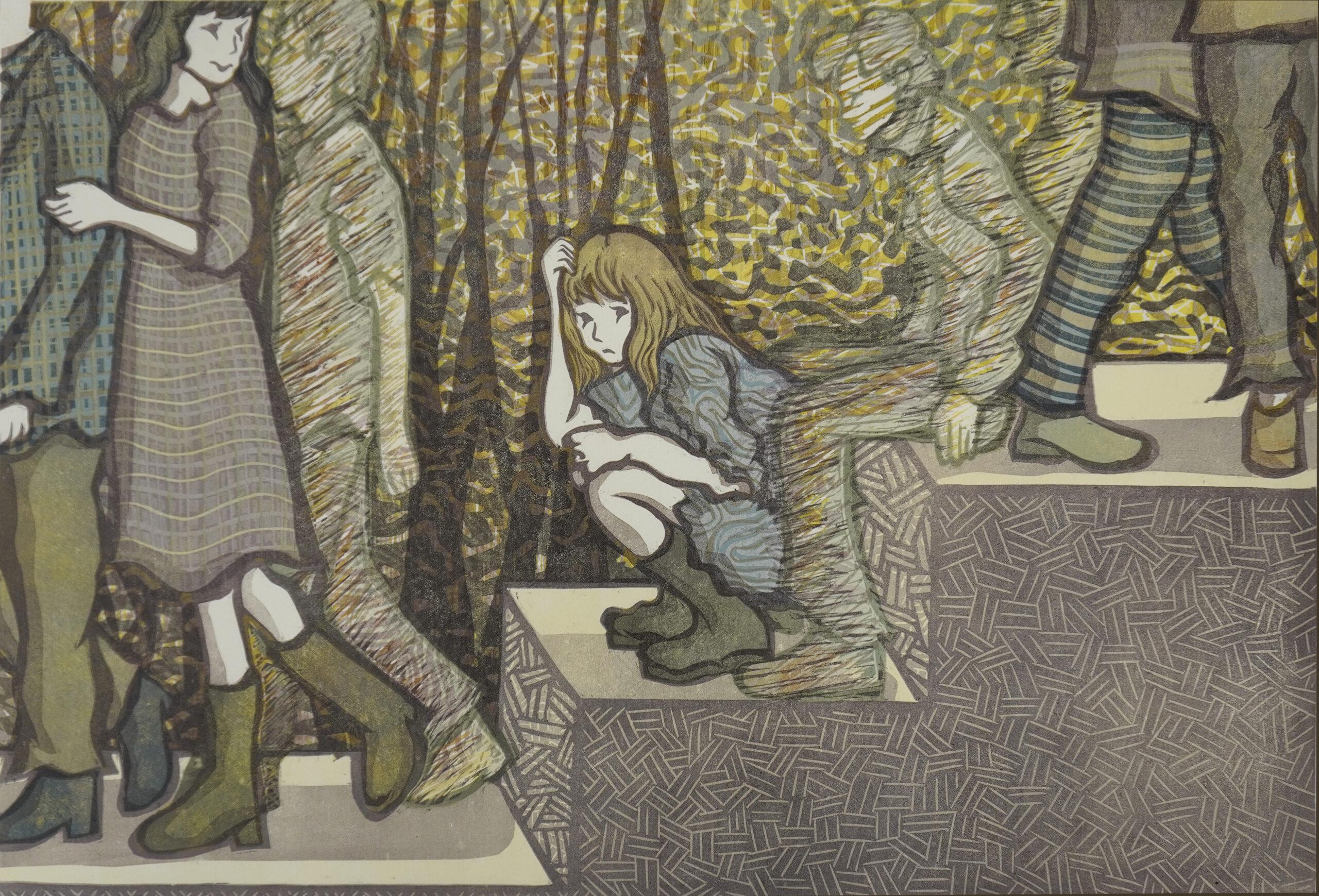Opening Statement
aaploit is pleased to present “community of,” a solo exhibition by Michimata Aoi from February 7 through February 24, 2025. This marks the artist’s third solo exhibition and serves as the inaugural presentation at aaploit’s new location in Bunkyo-ku, following the gallery’s recent relocation to a purpose-built contemporary art space. The exhibition confronts the pivotal moments in human experience—those instances when societal structures force individuals to pause, reflect, and choose their path forward. Through a distinctive interpretation of choice within social frameworks, Michimata presents a profound meditation on the intersections between personal agency and collective belonging, positioning individual decisions as both intimate acts and communal statements that resonate across the boundaries of private experience.
Exhibition Overview/Concept
The conceptual foundation of “community of” emerges from the theoretical framework of “Kafka’s Staircase,” a concept developed by social critic Takeshi Ikuta that serves as a metaphor for the oppressive weight of societal norms and expectations upon individual consciousness. This exhibition represents Michimata’s sustained engagement with questioning the assumed “normalcy” of social existence while simultaneously exploring the fundamental human need for belonging and place-making. The artist’s practice interrogates the tension between conformity and resistance, examining how individuals navigate the complex architecture of social expectations while maintaining authentic selfhood.
The exhibition’s title, “community of ,” with its deliberate trailing space, embodies the incomplete and ongoing nature of human belonging. This typographical choice reflects how individuals continuously navigate multiple communities throughout their lives—each affiliation bringing its own sense of comfort or unease, belonging or alienation. The empty space after “of” suggests the countless ways this phrase might be completed: community of workers, of outsiders, of believers, of the displaced. More significantly, it acknowledges the complex emotional geography of social belonging, where the same community that provides comfort to some may create discomfort for others, and where individual identity is constantly shaped by these shifting affiliations and the feelings they engender. The work presented here emerges from years of sustained inquiry into these themes, with each piece serving as a meditation on the meaning of choice itself—not merely as a personal act, but as a fundamental gesture that shapes both individual identity and communal reality.
Through this exhibition, Michimata addresses the universal question of “what it means to choose” by examining voices from society’s margins, challenging viewers to reconsider their own positioning within social hierarchies. The artist’s ongoing dialogue with established figures in contemporary art discourse—including recent conversations with internationally recognized curators—enriches her investigation into how personal decisions reverberate through collective experience, offering a space for reflection on the deeper dimensions of “divergence” in the relationship between individual and society.

Artistic Practice and Methodology
Michimata Aoi‘s artistic practice centers on woodblock printing, though her approach fundamentally challenges traditional conceptions of printmaking as a medium capable of producing multiple identical impressions. The artist employs a distinctive methodology where, despite using conventional printmaking techniques, she continues to carve and rework the wooden blocks throughout the creative process. While the completed woodblock remains after the artwork’s completion, it becomes impossible to produce identical works from the same matrix, transforming what would typically be an edition into a series of unique pieces.
This technical approach creates a fascinating paradox within contemporary art discourse. Although Michimata assigns edition numbers to her works, these numbers serve more as conceptual markers than traditional indicators of reproducibility. Each print becomes, in essence, a unique work—a “unique piece” that challenges the conventional boundaries between printmaking and other artistic media. This methodology reflects a deeper philosophical position regarding the nature of choice and iteration in creative practice. Each decision to carve further into the block represents an irreversible commitment, shaping all subsequent possibilities.
The artist’s choice of woodblock printing within contemporary art contexts can be understood as embracing a certain marginality relative to dominant modes of artistic expression. This positioning proves strategically significant, as it enables Michimata to develop a distinctive voice outside the mainstream currents of contemporary practice. The medium’s perceived “minor” status within current art discourse paradoxically becomes a source of strength, allowing for the articulation of perspectives that might otherwise be overwhelmed by more prominent artistic methodologies.
Through the medium of printmaking, individual experiences become inscribed with particular intensity and permanence. The physical act of carving—with its demands for decisive action and its resistance to easy revision—creates a direct parallel to the theme of choice that permeates the exhibition. Each mark cut into the wood represents an irreversible commitment, reflecting the broader human experience of navigating choices within social contexts.
Works and Spatial Experience
The central works in “community of” include pieces from Michimata’s ongoing “Kafka’s Staircase” series, where the metaphorical architecture of social pressure becomes literally rendered through the artist’s distinctive printmaking approach. These works present viewers with visual representations of the “divergence” points where individual agency meets collective expectation, rendered through the tactile immediacy of woodblock printing’s characteristic textures and tonal variations.
The “Kafka’s Staircase” pieces function both as individual contemplations and as components of a larger conceptual framework. Each work in the series explores different aspects of the tension between personal choice and social conformity, using the staircase metaphor to examine how individuals negotiate the step-by-step progression through societal structures. The visual language employed—characterized by bold contrasts and decisive linear elements—reflects the binary nature of many social choices while simultaneously revealing the complex gradations that exist within apparent simplicities.
The exhibition’s spatial arrangement at aaploit’s new location takes advantage of the gallery’s architectural features to create a journey through different scales of social belonging. The placement of works encourages viewers to move through the space in a manner that mirrors the decision-making processes explored in the artworks themselves, with each viewing position offering different perspectives on the relationship between individual and community.
New works created specifically for this exhibition extend Michimata’s investigation into contemporary manifestations of social choice, examining how digital connectivity and global awareness have complicated traditional notions of community belonging. These pieces maintain the artist’s distinctive technical approach while addressing the particular challenges of place-making in an increasingly connected yet fragmented world.
Critical Context and Contemporary Relevance
Michimata’s work emerges within a broader context of contemporary Japanese art that grapples with questions of social positioning and individual agency in post-bubble economic reality. Her investigation of “Kafka’s Staircase” connects to longstanding concerns within Japanese society regarding the pressures of social conformity, while her focus on marginalized voices reflects contemporary awareness of the need for diverse perspectives within artistic discourse.
The artist’s engagement with printmaking as a medium carries particular significance within Japanese artistic traditions, where woodblock printing holds deep historical and cultural resonance. By employing this traditional medium to explore contemporary social questions, Michimata creates a productive tension between historical continuity and present-moment urgency. Her work participates in ongoing conversations about how traditional artistic practices can address current social realities without becoming trapped in nostalgic reproduction.
Within the broader context of contemporary art’s engagement with community and belonging, Michimata’s work offers a distinctive perspective that neither romanticizes collective experience nor dismisses its importance. Instead, her practice examines the complex negotiations required to maintain both individual authenticity and social connection, recognizing these not as opposing forces but as interdependent aspects of human experience.
The exhibition’s timing, coinciding with aaploit’s relocation and expansion, reflects broader shifts within Tokyo’s contemporary art landscape. The gallery’s commitment to presenting challenging, conceptually rigorous work within an international context provides an ideal framework for Michimata’s investigation of universal themes through culturally specific methodologies.
Artist Information
Michimata Aoi has developed her distinctive artistic practice through sustained investigation of social structures and individual agency, with particular focus on the experiences of those who exist at the margins of dominant social narratives. Her previous solo exhibitions have explored related themes of belonging and choice, establishing a coherent body of work that combines technical innovation with conceptual rigor.
The artist’s educational background and artistic development have been shaped by deep engagement with both traditional Japanese printmaking techniques and contemporary critical theory. This dual foundation enables her to approach historical artistic methods with contemporary awareness, creating work that honors traditional practices while addressing present-moment concerns.
Michimata’s research focus centers on the ways individual experiences of social pressure and choice can be understood as collective phenomena, examining how personal decisions both reflect and shape broader social realities. Her work has been recognized for its thoughtful integration of technical skill and conceptual depth, demonstrating how traditional artistic methods can serve contemporary critical inquiry.
The artist’s practice continues to evolve through ongoing investigation of community formation, social belonging, and the role of choice in shaping both individual identity and collective experience. Her commitment to exploring these themes through the specific materiality and methodology of woodblock printing reflects a broader understanding of how medium and message interact within contemporary artistic practice.
Exhibition Details
“community of”
Artist: Aoi Michimata
Dates: February 7 – February 24, 2025
Hours: Friday, Saturday, Sunday 13:00-18:00
*Final day Monday, February 24, also open 13:00-18:00
*Private appointments available on weekdays
Venue: aaploit
TMK Building 2F, 1-21-17 Sekiguchi, Bunkyo-ku, Tokyo
Inquiries: info@aaploit.com
